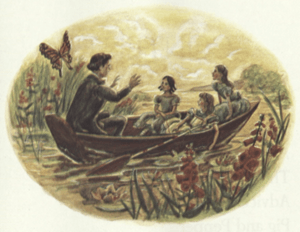All in the golden afternoon... facts for kids
All in the golden afternoon is a special poem that starts Lewis Carroll's famous 1865 book, Alice's Adventures in Wonderland. This poem tells the story of the afternoon when Carroll first made up the tale of Alice in Wonderland. He was on a boat trip from Oxford to Godstow with three sisters: Lorina Charlotte, Alice Pleasance, and Edith Mary. Alice Pleasance Liddell was the girl who inspired the main character, Alice.
The poem has been used in different ways in movies and plays based on Alice's Adventures in Wonderland. For example, in Walt Disney's 1951 animated movie, it was used as a song title. A 1972 play by André Gregory also used parts of the poem to introduce the story. The German band Alphaville even changed the poem slightly to use as song lyrics.
Contents
The Poem: All in the Golden Afternoon
All in the golden afternoon
Full leisurely we glide;
For both our oars, with little skill,
By little arms are plied,
While little hands make vain pretence
Our wanderings to guide.
Ah, cruel Three! In such an hour,
Beneath such dreamy weather,
To beg a tale of breath too weak
To stir the tiniest feather!
Yet what can one poor voice avail
Against three tongues together?
Imperious Prima flashes forth
Her edict "to begin it"—
In gentler tones Secunda hopes
"There will be nonsense in it!"—
While Tertia interrupts the tale
Not more than once a minute.
Anon, to sudden silence won,
In fancy they pursue
The dream-child moving through a land
Of wonders wild and new,
In friendly chat with bird or beast—
And half believe it true.
And ever, as the story drained
The wells of fancy dry,
And faintly strove that weary one
To put the subject by,
"The rest next time—" "It is next time!"
The happy voices cry.
Thus grew the tale of Wonderland:
Thus slowly, one by one,
Its quaint events were hammered out—
And now the tale is done,
And home we steer, a merry crew,
Beneath the setting sun.
Alice! A childish story take,
And with a gentle hand,
Lay it where Childhood's dreams are twined
In Memory's mystic band,
Like pilgrim's withered wreath of flowers
Plucked in far-off land.
How the Poem is Written
"All in the golden afternoon" is a poem with seven sections, called stanzas. Each stanza has six lines. The poem follows a pattern for its rhymes. The second, fourth, and sixth lines of each stanza rhyme with each other. For example, if the first line ends with 'A', the second with 'B', the third with 'C', then the fourth line will also end with 'B', and the sixth line will end with 'B'. This pattern is called ABCBDB.
The lines that rhyme (the 'B' lines) are usually shorter than the others. The lines that don't rhyme are typically longer.
The first part of the poem also plays a clever word game. It uses the word "little" three times. This was a playful nod to the Liddell sisters, whose last name sounded very similar to "little."
The Story Behind the Poem
How Alice in Wonderland Began
This poem tells the true story of how Lewis Carroll (whose real name was Charles Lutwidge Dodgson) created Alice's Adventures in Wonderland. It happened in the summer of 1862. Carroll was with the three Liddell sisters and a friend, Reverend Robinson Duckworth.
Alice Pleasance Liddell was 10 years old when Carroll first told stories about Wonderland. Alice and her two sisters spent a lot of time with Carroll and Duckworth. They often went on boat trips up the River Thames, bringing picnic baskets and learning how to row. It was during one of these trips that the first Alice story was told.
From Story to Book
The story might have been forgotten if Alice hadn't asked Carroll to write it down just for her. The very first copy of Alice's Adventures in Wonderland was a handwritten book. It was called Alice's Adventures Under Ground back then. Carroll gave it personally to Alice Liddell, who was the inspiration for the main character.
When the story was going to be published as a real book, Carroll added this poem as an introduction. He thought his story might be a bit scary for young children. He hoped the poem would make the story seem less frightening and welcome readers into Wonderland.
Carroll also changed the dedication. He removed the original message, which said: "A Christmas Gift to a Dear Child in Memory of a Summer Day." Instead, he put the last stanza of the poem as a special message to Alice. It was a secret nod to their shared adventure in creating Wonderland.
What Really Happened That Day
The poem closely matches what Alice Liddell remembered about those summer outings. In the fifth stanza, the "weary one" is Carroll himself. Alice remembered him saying, "And that's all till next time." She and her sisters would always reply, "Ah but it is next time!" These small details help confirm the history behind the poem.
Carroll and Alice both said the day of the boat trip described in the poem was "burning" hot. However, it's funny to know that the actual day they mentioned was cloudy, rainy, and not very "golden" at all!


